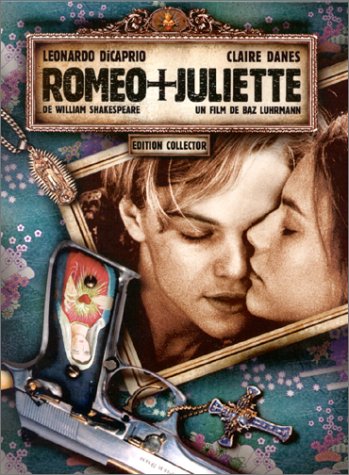Shakespeare’s original play, Romeo and Juliet and Luhrmann’s appropriated version, both investigate different types of conflict. The two texts are set in completely contrasting social and historical contexts of Elizabethan England to Southern California in Verona Beach.
Despite the contrast of the two settings, both texts explore the external conflict which stemmed from the family feud between the Capulets and the Montagues.
Shakespeare utilizes a variety of literary techniques to shape the ideas of conflict, through major fights which result in significant deaths, a minor conflict that reiterates the ever-present feud, and the dispute between the two families. Luhrmann modifies these concepts in his rendition to conform to a contemporary audience.
Conflict is shaped and reshaped in the text through Act 3 Scene 1, which resulted in the deaths of Tybalt and Mercutio. The conflict escalates between Tybalt and Mercutio, as Mercutio provokes Tybalt to engage in a fight after Tybalt confronts Romeo.
Romeo follows with the exasperated remark, “Gentlemen, for shame! Forbear this outrage. Tybalt, Mercutio!” This emphasizes Romeo’s reluctance for a fight to break out, highlighted through his desperate tone, as he pleads for them to stop before blood is shed.
Tybalt’s ignorance and urge to fight leads to Mercutio’s death, as well as his own. As Mercutio dies, he howls “A plague on both your houses!” This quote is significant, as it foreshadows the tragic fate of Romeo and Juliet in later scenes. Luhrmann’s modification of Shakespeare’s Act 3 Scene 1 creates a deeper understanding of the text.
Luhrmann conveys the flow of emotion and tone of the scene through POV shots which capture Tybalt and Mercutio’s fight. Tybalt is constantly presented with low-angle shots, suggesting that he is the dominating figure.
This suggests that Tybalt and the Capulets have the upper hand in the feud, and this is further propagated throughout the film. This is how Shakespeare and Luhrmann have shaped and reshaped ideas of conflict in the text, Romeo and Juliet.
There are other minor conflict scenes in the play, especially in act one scene five during the masquerade ball at the Capulet’s house. This scene features many minor conflicts between characters. An example is between Tybalt and Lord Capulet when Tybalt spots Romeo, at the venue, wanting to draw his sword.
Shakespeare has used different tones to express each character’s perspectives. Through “Patience perforce with wilful choler meeting, makes my flesh tremble in their different greeting.” The audience can understand that Tybalt is clearly dishonored and frustrated. This is evident through the techniques shown in the speech. One technique is the way he starts his declamation with a powerful alliteration in the quote by Tybalt.
This shows the audience the anger built inside the character by reinforcing the consonant sounds. The film portrays the same effect but through a different process. Luhrmann has transformed Shakespeare’s original masquerade ball into a casual costume party.
The attire used in the film was deliberate, to stress certain characteristics. Lord Capulet dressed as Julius Caesar emphasizes the power he has against Tybalt who is only a devil looking for mischief, provoking the audience to think about the roles of each character in the film. Despite the differences between the two methods, Shakespeare and Luhrmann have both shaped and reshaped the same idea of conflict in the text Romeo and Juliet.
The last idea which demonstrates conflict is disagreement within families. In act 3 scene 5, Juliet confesses to her father, Lord Capulet of her love for Romeo. This scene shows the ruthlessness of Lord Capulet towards Juliet and the vulnerability of her in contrast. The hostile words, “Hang thee, young baggage! Disobedient wretch!” by Lord Capulet, uses a biting tone against Juliet.
By doing so, Lord Capulet’s power is emphasized, and the audience sympathizes with Juliet’s situation. Similarly, in Luhrmann’s film, the same tone is used in Lord Capulet’s speech. However, the film adds to the emotions evoked in the audience by using different camera angles and shots. Most of the time, the camera uses a low angle when Lord Capulet is in the scene, as the powerful upper hand.
In contradiction, high angles are used when Juliet is shot, making the subject look helpless. Close-up shots are also used to show each character’s emotions, building suspense and provoking emotions. This shows the audience Lord Capulet’s arrogance and hostility, as well as emphasizing his power and leadership shown in previous scenes. Ideas of conflict have been shaped by Shakespeare, and reshaped in Luhrmann’s appropriation, through these ideas in the text Romeo and Juliet.
Through all the given information, it can be concluded that Shakespeare and Luhrmann have both used the text, Romeo and Juliet, to explore the different ideas of conflict by shaping and reshaping.
By introducing both major and minor conflicting scenes between the two feuding families, as well as conflict within each family, the audience can thoroughly understand the idea of conflict across age groups. Shakespeare’s original play Romeo and Juliet and Luhrmann’s appropriated film Romeo and Juliet has been shaped and reshaped holding these ideas of conflict.

